Although many aquarium fish live relatively short lives, some enjoy impressive lifespans as long as you provide your pets with a high-quality diet and optimal living conditions. So, before taking on any of the following fishy friends, remember that you could be taking on a lifelong commitment, and in some cases, your pet could outlive you!
Keep reading to discover ten amazing fish species that typically enjoy surprisingly long lifespans.
Key Takeaways
- Lifelong companions: Certain aquarium fish like Koi and Lungfish have the potential for extraordinarily long lifespans, providing their owners with companionship for decades if provided with optimal living conditions.
- Habitat and diet are pivotal: Ensuring a large, well-equipped tank to accommodate your fish’s growth, along with a balanced diet, is essential for their health and longevity; for example, Lungfish will need a tank of at least 600 gallons and a specialist carnivorous diet to grow and thrive.
- Consider the commitment: The remarkable longevity of fish such as Methuselah, a Lungfish possibly nearing 100 years old, highlights the importance of considering the potential long-term commitment involved in fishkeeping.
Summary Table
| Name | Scientific Name | Tank Size | Life Expectancy | Diet | Behavior | Ideal Water Parameters |
|---|---|---|---|---|---|---|
| Lungfish | Neoceratodus forsteri | 600 gallons or more | 25 years or more | Carnivorous (earthworms, shrimp, fish fillets) | Often hides, needs hiding places | pH: 6.5-7.5, Temp: 76-86°F (24-30°C) |
| Koi Fish | Cyprinus carpio | 1000 gallons or more | Over 50 years | Omnivorous (high-quality pellets, vegetables) | Active, social, needs space to swim | pH: 7.0-8.0, Temp: 35-75°F (1.7-24°C) |
| Goldfish | Carassius auratus | 20 gallons per fish | 10 to 20 years or more | Omnivorous (pellets, veggies, frozen foods) | Social, produces a lot of waste | pH: 6.0-8.0, Temp: 68-74°F (20-23.5°C) |
| Clown Loach | Chromobotia macracanthus | 75 gallons | 10 to 20 years or more | Omnivorous (sinking pellets, meaty foods, veggies) | Active, social, enjoys hiding | pH: 6.0-7.5, Temp: 77-86°F (25-30°C) |
| Bristlenose Pleco | Ancistrus sp. | 20 gallons or more | 10-15 years or more | Herbivorous (algae wafers, blanched vegetables) | Peaceful, hides during the day | pH: 6.5-7.5, Temp: 60-80°F (15-27°C) |
| Archerfish | Toxotes sp. | 50 gallons or more | 7 to 10 years or more | Carnivorous (live/frozen insects, high-quality pellets) | Shy, prefers subdued lighting | pH: 7.0-8.0, Temp: 75-86°F (24-30°C) |
| Discus Fish | Symphysodon spp. | 50 gallons for a group | 10 to 15 years or longer | Omnivorous (pellets and frozen meaty foods) | Sociable, prefers groups | pH: 6.0-7.0, Temp: 82-88°F (27.5-31°C) |
| Oscar Fish | Astronotus ocellatus | 75 gallons for one | 10 to 15 years or more | Omnivorous (pellets, frozen foods, live prey) | Intelligent, can be territorial | pH: 6.0-8.0, Temp: 74-81°F (23-27°C) |
| Arowana | Osteoglossum spp. | 200+ gallons for juveniles, 500+ for adults | 10 to 20 years or more | Carnivorous (fish, shrimp, insects) | Can be solitary, a potential jumper | pH: 6.0-7.0, Temp: 75-82°F (24-28°C) |
| Rainbowfish | Melanotaeniidae family | 30 gallons for a group | 5 to 10 years or more | Omnivorous (tropical fish flakes, live/frozen foods) | Peaceful, school in groups | pH: 7.0-8.0, Temp: 74-78°F (23-26°C) |
Please note that these tank sizes are general recommendations based on adult size and social behavior. The actual requirements can vary based on the specific species within these groups and their individual needs.
Lungfish (Neoceratodus forsteri)
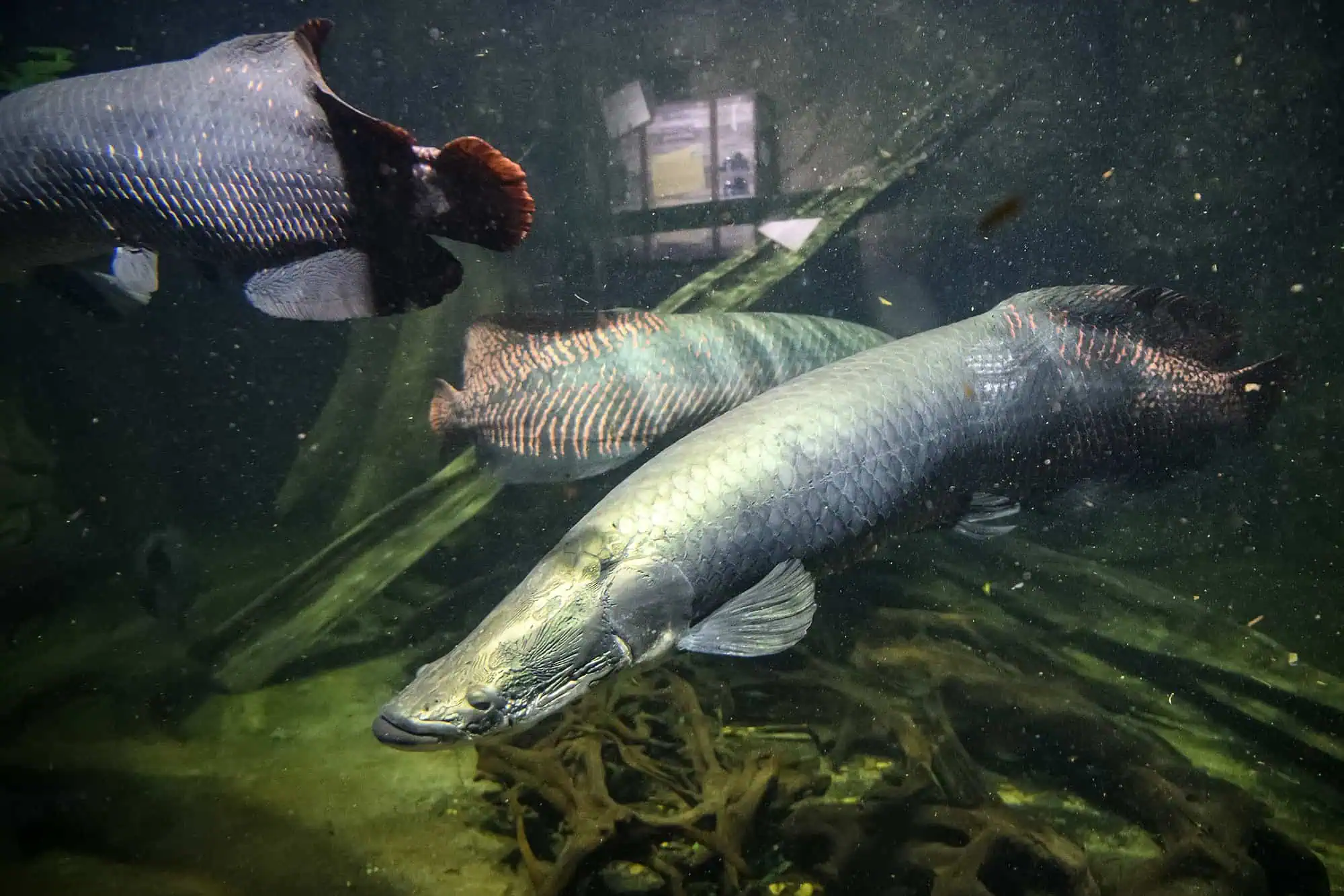
- Average lifespan: 25 years or more
- Origins: Africa, South America, Australia
- Minimum tank size: 600 gallons
According to a new study, the longest-lived aquarium fish in the world is a lungfish called Methuselah, which is reputedly over 100 years old.
The fish in question is a female Australian lungfish that lives in San Francisco’s Steinhart Aquarium, California. The fish first arrived at the facility in 1938 and was thought to be 84 years old. However, recent research suggests Methuselah is, in fact, closer to 100 years of age.
These fish can grow to an impressive 4 feet in length, so you’ll need a large aquarium with ample swimming space to keep one! Lungfish also tend to hide when stressed, so you’ll need to provide your pet with lots of hiding places to retreat to.
Since these fish are large carnivores, it’s essential to maintain excellent water quality in the tank through adequate filtration and regular water changes. Offer your giant pet a diet consisting of meaty foods such as earthworms, shrimp, and fish fillets supplemented with sinking pellets or sticks specially formulated for large carnivorous fish.
Koi Fish (Cyprinus carpio)

- Average lifespan: Over 50 years
- Origins: Asia
- Minimum pond size: Varies depending on stocking levels and fish size
Koi fish are renowned for their longevity, with some specimens surviving for well over 50 years when provided with proper care.
Originating from Asia, particularly Japan, Koi are best suited to ponds rather than aquariums because of their large size and active swimming habit. The minimum pond size you’ll need for these fish depends on the stocking levels and the fish’s size, but a general rule of thumb is to provide at least 1000 gallons for several adults.
Koi fish need a well-balanced pond environment with good filtration and aeration and plenty of open water swimming space. They also appreciate dense planting where they can hide and rest.
Feed the Koi a varied diet consisting of high-quality pellets, vegetables, and occasional treats like live or frozen foods to enhance their glowing, vibrant colors.
Goldfish (Carassius auratus)
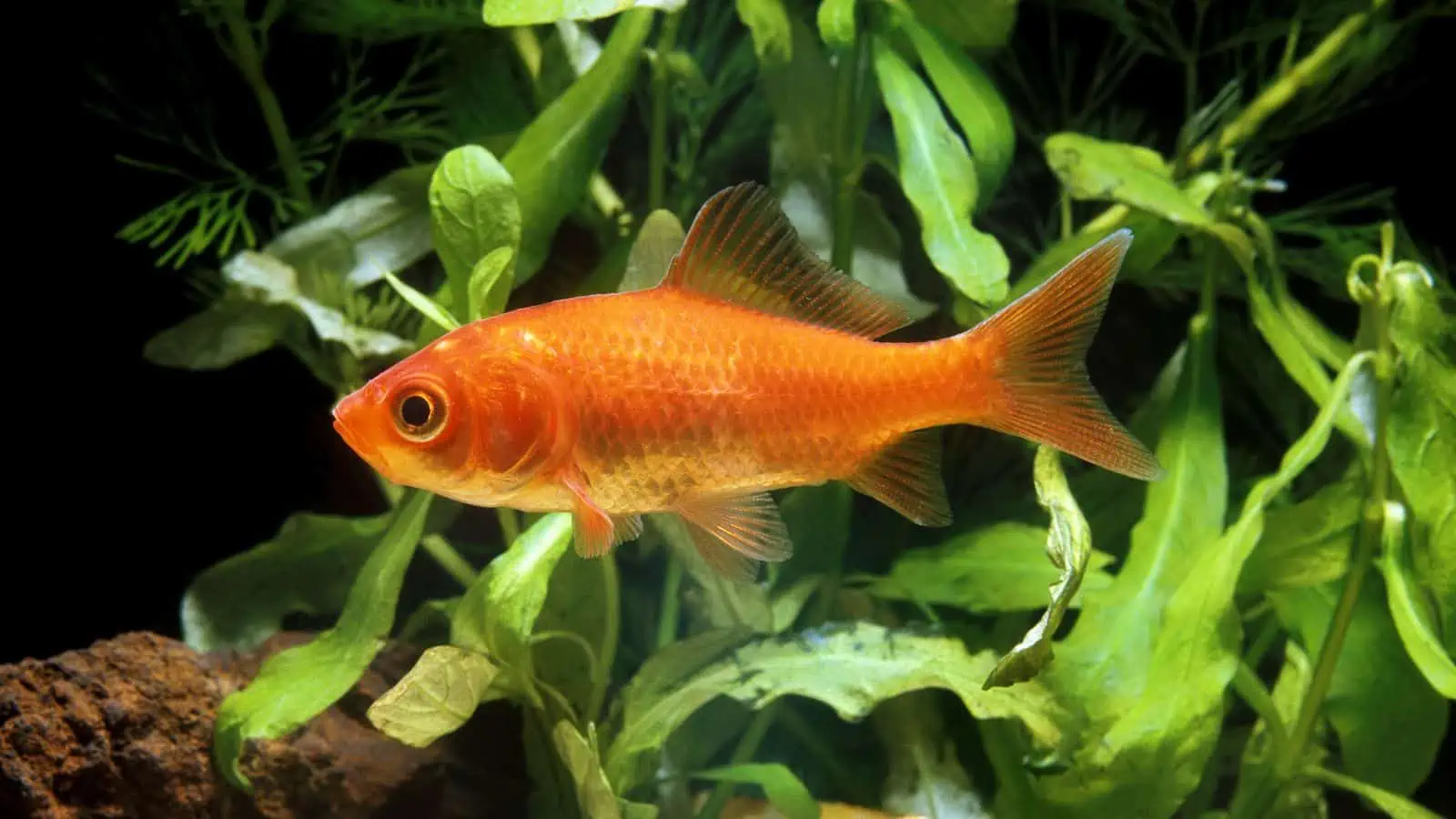
- Average lifespan: 10 to 20 years or more
- Origins: Asia
- Minimum tank size: 20 gallons per adult fish
Most hobbyists started their fishkeeping journey by keeping a few humble goldfish; I know I did! When given the correct care and a suitable diet, goldfish can live for an average of 10 to 20 years or longer.
Fancy goldfish are distantly related to wild carp but don’t exist in wild populations. They are an artificially created species raised for their bright colors and unusual forms. Although pretty hardy and able to tolerate a wide range of water conditions, providing a stable and clean environment is crucial for their health and longevity.
Fancy goldfish can grow to around 8 inches long and should always be kept in small groups, so they need a spacious tank or well-maintained garden pond. These fish also create a lot of waste, so you need a good filtration system and regular water changes to keep the water clean and safe for your fish.
I feed my fancies a balanced diet of high-quality pellets specially formulated for round-bodied varieties, supplemented with fresh veggies and meaty frozen foods.
Clown Loach (Chromobotia macracanthus)

- Average lifespan: 10 to 20 years or more
- Origins: Southeast Asia
- Minimum tank size: 75 gallons
Clown loaches are fun, popular freshwater aquarium fish that can add a splash of color and personality to your tank. These playful characters can live for up to 20 years when provided with optimal aquarium conditions and a suitable diet.
These active loaches can be territorial and generally do best when kept in groups of at least five in a large tank with plenty of hiding places and soft substrate in which to burrow.
You’ll need to maintain stable water parameters, especially water temperature and pH levels, and ensure good water quality through well-maintained, adequate filtration. Offer a varied diet of sinking pellets, frozen meaty foods, and fresh veggies to encourage your loaches to display brighter colors and live to their maximum life expectancy.
Bristlenose Pleco (Ancistrus sp.)

- Average Lifespan: 10-15 years or more
- Origins: South America
- Minimum Tank Size: 20 gallons
Bristlenose plecos are popular freshwater algae-eaters, probably best known for their unique appearance. But did you know that these weird-looking creatures can survive for as long as 15 years in the aquarium, giving their owners many years of enjoyment?
As a bonus to their longevity, Bristlenose plecos provide a valuable service to hobbyists by grazing on algae and organic matter, helping to keep the tank clean and tidy.
These fish need a tank of at least 20 gallons with plenty of hiding spots, rocks, and driftwood to replicate their natural habitat. This species is very sensitive to poor water conditions, so you need to ensure good water quality through filtration and regular water changes.
Feed these quirky fish a diet of sinking algae wafers, blanched vegetables, and occasional protein-rich frozen foods to supplement their diet and promote optimal health and growth.
Archerfish (Toxotes sp.)

- Average lifespan: 7 to 10 years or more
- Origins: Southeast Asia, Australia
- Minimum tank size: 50 gallons
Archerfish are fascinating freshwater fish that many aquarists simply pass by, thinking of them as somewhat plain when compared with brighter-colored species like Rainbowfish and tetras. That’s a shame, as these fish are survivors, providing you with up to ten years of enjoyment when given the correct conditions and diet.
This species does best when kept in a large tank with plenty of open swimming space and a tight-fitting lid to prevent escape attempts. Archerfish prefer subdued lighting, which you can provide with a raft of floating plants that also offer cover for these shy fish.
In the wild environment, Archerfish hunt and catch insects by spitting a jet of water at any prey that’s flying overhead and grabbing the victim once it hits the water. In captivity, you can feed the fish a varied diet consisting of live or frozen insects, high-quality pellets, and flakes.
Discus Fish (Symphysodon spp.)
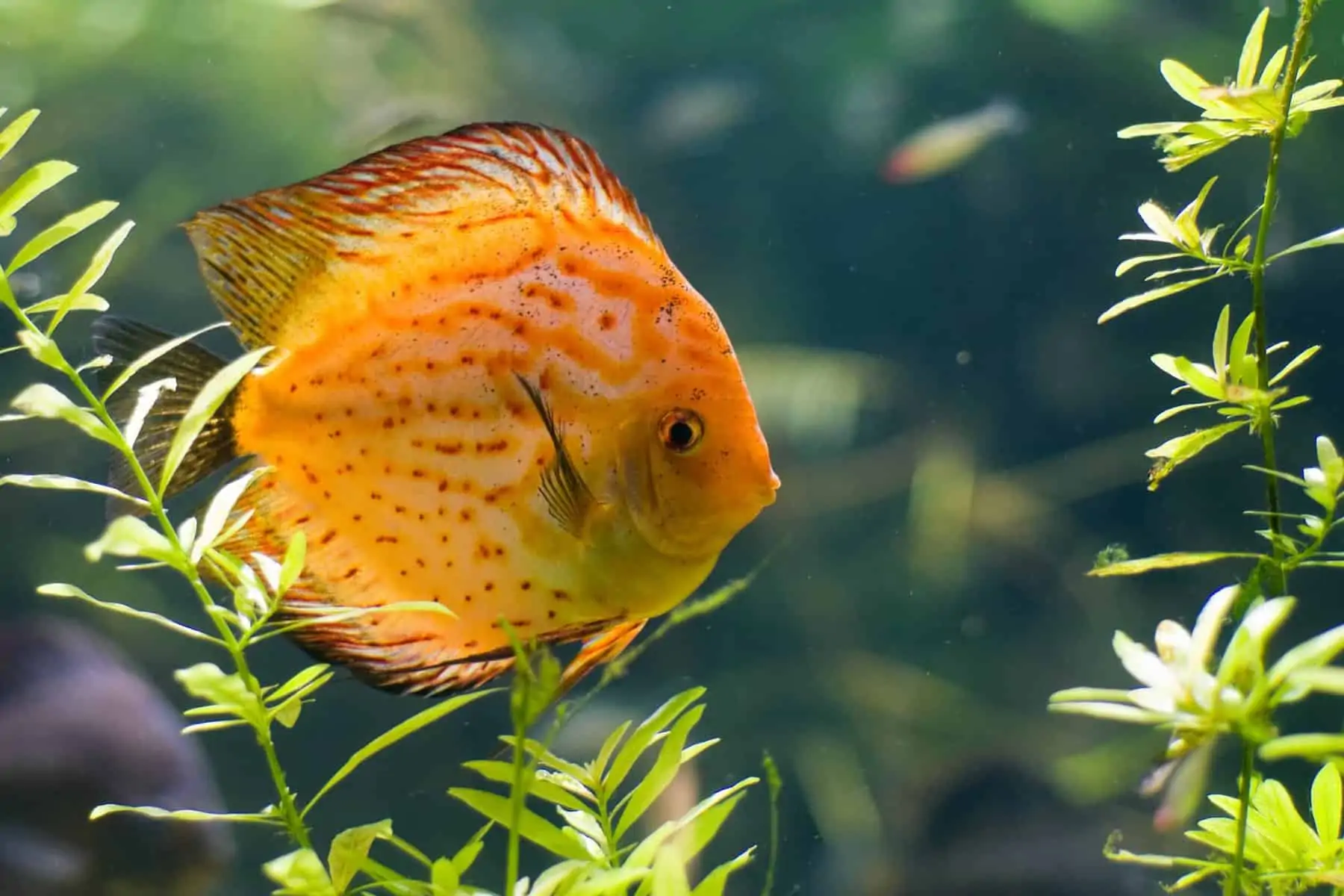
- Average lifespan: 10 to 15 years or longer
- Origins: South America
- Minimum tank size: 50 gallons for a small group
Discus fish can make an elegant addition to a tropical tank with their graceful swimming style and vibrant colors. In addition, these fish often live for up to 15 years or even more in well-maintained aquariums.
Since these fish are quite large, they need a spacious tank with plenty of space to swim and do best in well-maintained tanks with pristine water and stable conditions. Discus fish are typically sociable creatures and should be kept in small groups, which also helps to minimize aggression.
Offer your Discus a varied diet consisting of high-quality pellets and frozen meaty foods. Feeding live food occasionally is a great idea, as that helps promote the fish’s vibrant colors. Regular water changes and good filtration are essential to maintain excellent water quality for these sensitive fish.
Oscar Fish (Astronotus ocellatus)
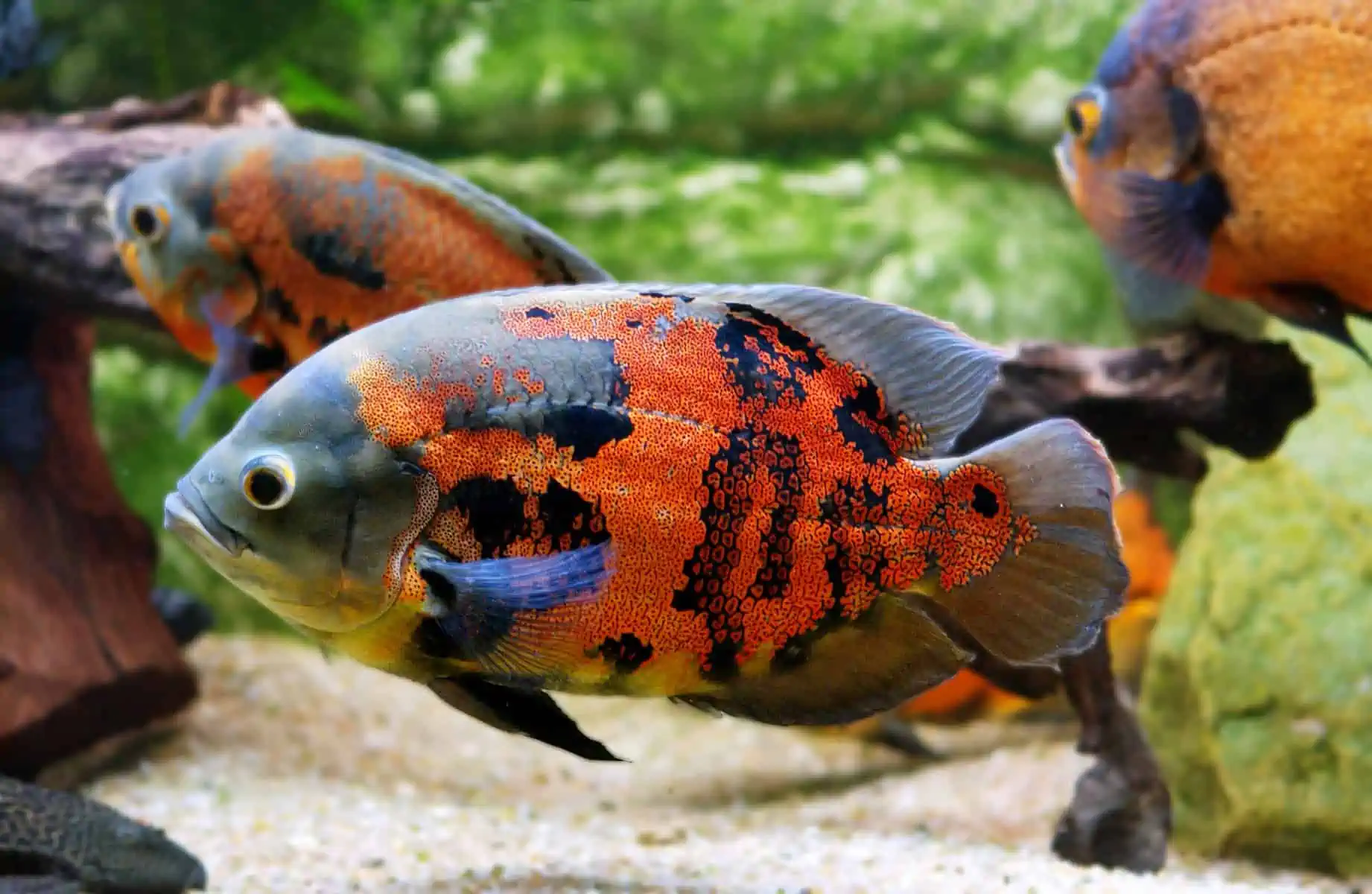
- Average lifespan: 10 to 15 years or more
- Origins: South America
- Minimum tank size: 75 gallons for a single fish
Oscars are large, charismatic freshwater fish known for their intelligence and longevity. These spectacular fish need a large tank of at least 75 gallons for one fish, with ample open water swimming space and plenty of places to hide.
Since Oscars are sensitive to poor water conditions, your aquarium needs excellent water quality, so a powerful filtration system and regular water changes are essential. Offer your fish a varied diet of Oscar pellets, frozen foods, and occasional live prey to meet their nutritional needs and encourage natural behaviors.
A stable water temperature and pH are essential for these large fish to thrive and live to their full life expectancy.
Arowana (Osteoglossum spp.)
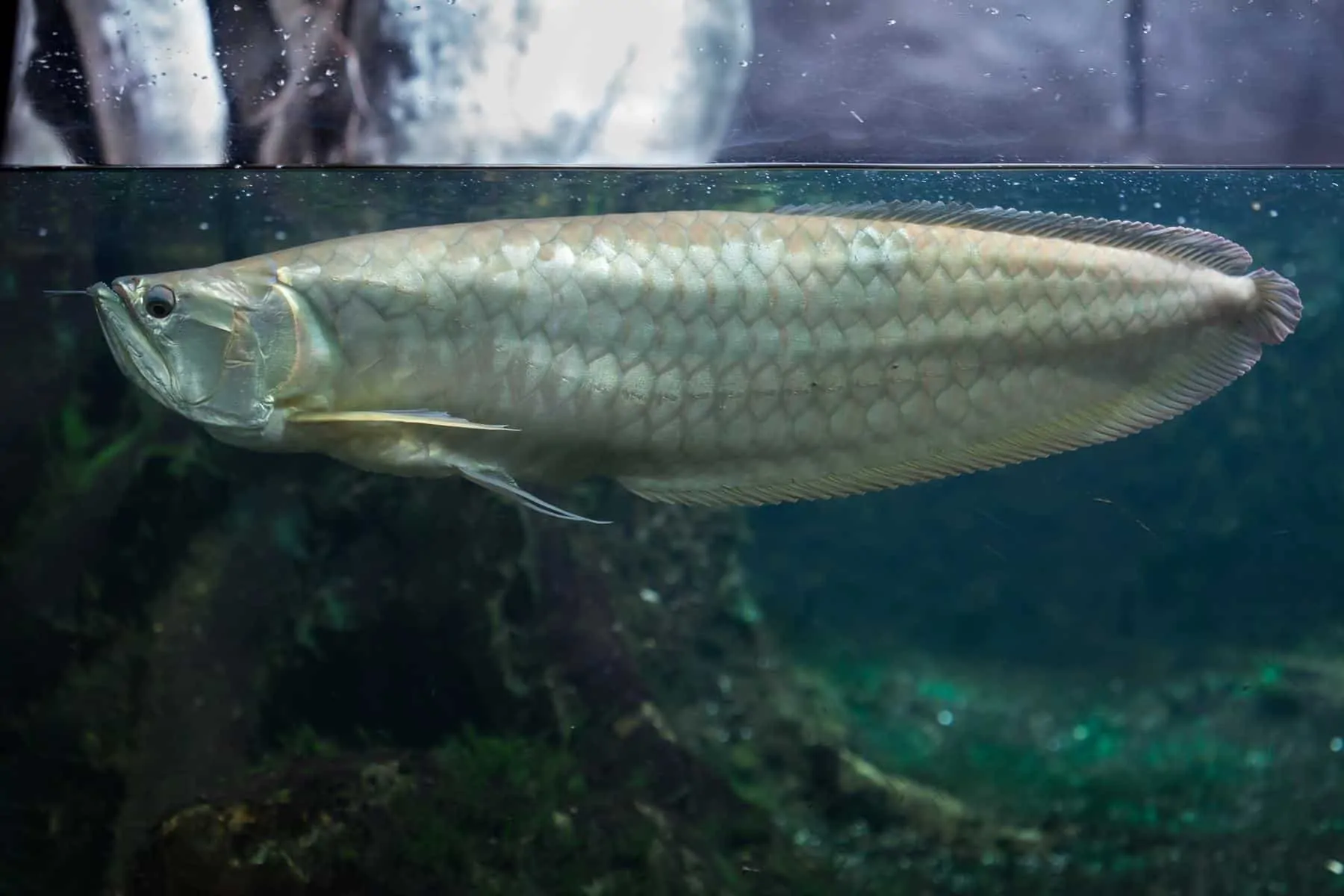
- Average lifespan: 10 to 20 years or more
- Origins: South America, Asia, Australia
- Minimum tank size: 200 gallons for juveniles, 500 gallons or more for adults
If you have a very big tank and want to keep just one exhibition specimen, an Arowana might be a species to consider.
Arowanas are majestic freshwater carnivores that can live for over 20 years in some cases, so taking on one of these bad boys could be a lifelong commitment! You’ll need a huge tank for juveniles and an even larger one for one fully-grown adult fish. These fish are notorious jumpers, so your tank must have a tight-fitting lid to prevent escape attempts.
And if you have a massive aquarium, note that these are solitary fish; keeping more than one can result in aggression and stress.
Arowanas need a protein-rich diet that includes frozen or live foods, including fish, shrimp, and insects, supplemented with high-quality pellets or floating sticks. As you’d expect with a large carnivore, these fish tend to produce a lot of waste, so you’ll need a powerful filtration system to keep the water clean and safe for them.
Rainbowfish (Melanotaeniidae family)
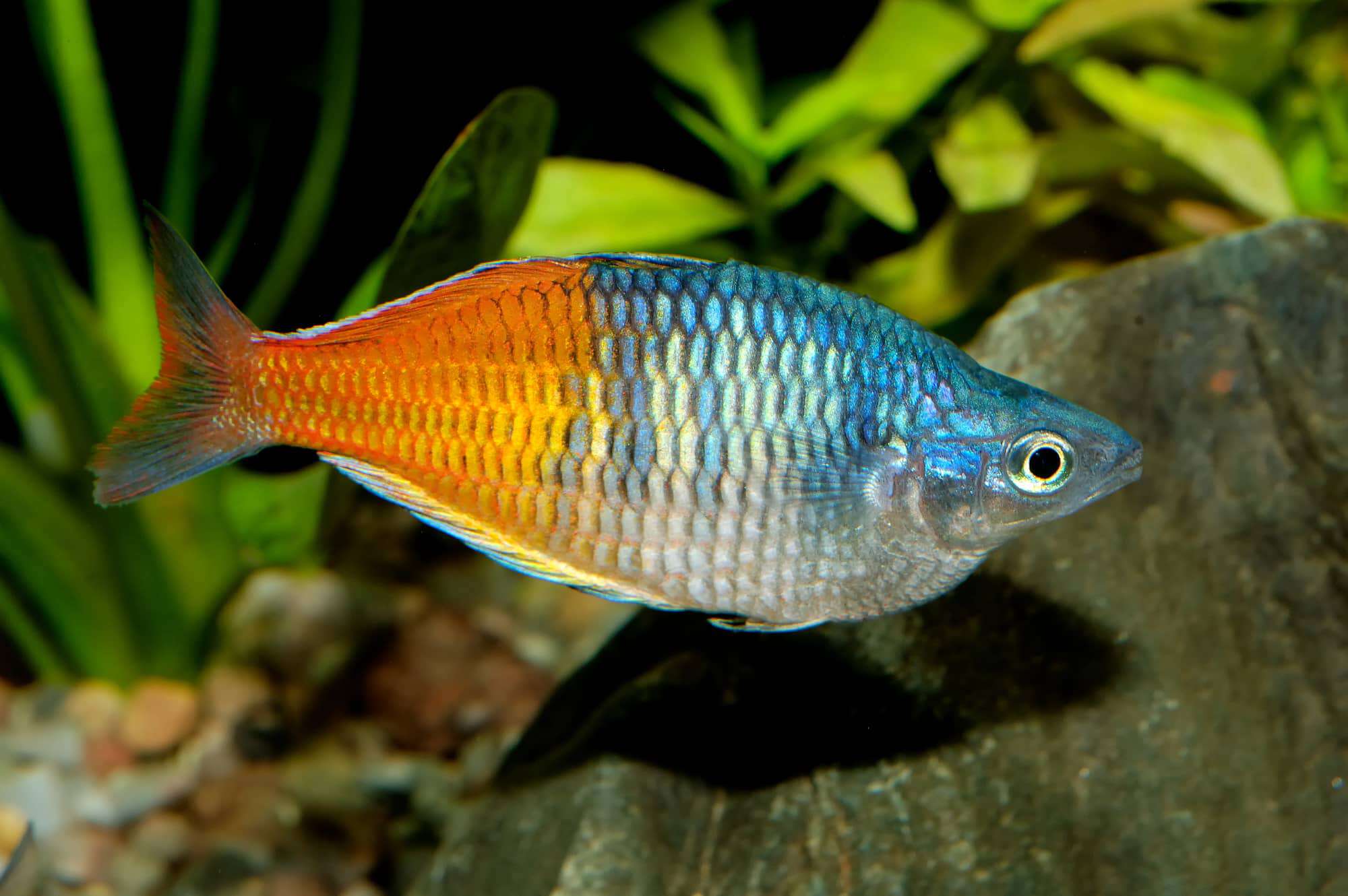
- Average lifespan: 5 to 10 years or more
- Origins: Australia, New Guinea, Southeast Asia
- Minimum tank size: 30 gallons for a small group
As their name suggests, Rainbowfish are colorful, active freshwater fish that are a favorite with hobbyists thanks to their vivid colors and relatively long lifespan.
These beautiful fish thrive when kept in small social groups, but they need a spacious tank of at least 30 gallons with plenty of space to school. To prevent stress and disease, maintain stable water parameters, including temperature and pH, within the fish’s preferred range. Rainbowfish can be sensitive to water quality, so it’s vital to run an efficient filtration system and perform regular water changes to keep the environment clean and safe for your aquatic pets.
These fish appreciate a varied diet, including high-quality tropical fish flakes and pellets. Include occasional helpings of live or frozen foods to enhance their vibrant colors.
Final Thoughts
Although many aquarium fish have relatively short lifespans of one to four or five years, there are some notable exceptions to that rule.
For example, Methuselah the Lungfish is thought to be around 100 years old. Now, that’s more than a lifelong commitment for any hobbyist! However, there are plenty of fish you could choose that will survive for up to 20 years, provided you give them the right care and diet.
Before taking on any fish, ensure you research the species thoroughly and can provide your new pet with the correct size of a tank, a high-quality diet, and a well-maintained environment that closely replicates its natural habitat. If you can tick all those boxes, you can look forward to enjoying the company of your new fishy friend for its full life expectancy and beyond!


